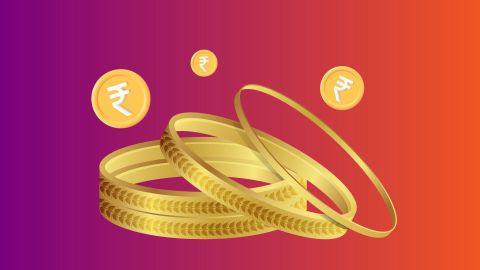2 mins
10 December 2024
Gold melt loss is a critical concept for anyone involved in recycling, refining, or selling gold. It refers to the reduction in weight that occurs during the melting or refining process of gold, often due to impurities or material loss. Understanding this concept is essential for maintaining accuracy in gold valuation, especially when dealing with scrap gold. This guide explores gold melt loss, its causes, calculations, and its impact on transactions like gold loans, ensuring you make informed decisions.
Causes of gold melt loss in scrap
Gold melt loss in scrap occurs due to various factors, primarily related to the composition and condition of the gold being melted. One of the main causes is the presence of non-gold alloys, such as copper or silver, which burn off during the melting process. Contaminants like dirt, dust, or adhesives from old jewellery also contribute to weight reduction. Oxidation during high-temperature melting can lead to further material loss. Poor handling techniques, such as overheating, may result in unnecessary evaporation of gold. Additionally, unaccounted residues from soldering or mixed materials in scrap gold can significantly increase melt loss. Understanding these causes helps jewellers and refiners implement better practices to minimise weight reduction and improve the efficiency of the refining process.
How is gold melt loss calculated?
Gold melt loss is calculated by measuring the weight difference before and after the melting or refining process. The initial weight of the scrap gold is recorded, and after melting, the refined gold’s weight is measured. The difference between the two weights represents the melt loss. This is typically expressed as a percentage to indicate the extent of loss. For example, if 100 grams of scrap gold results in 90 grams of refined gold, the melt loss is 10%. This calculation helps refiners and jewellers accurately estimate the purity and value of the final product. Factoring in melt loss ensures fair valuation, particularly when dealing with transactions involving gold purity or gold loans.How to minimise gold melt loss in scrap?
Minimising gold melt loss requires implementing best practices during the melting and refining process. First, ensure that scrap gold is cleaned thoroughly to remove contaminants such as dirt, adhesives, or residue. Using advanced refining techniques, such as induction melting, reduces unnecessary material loss compared to traditional methods. Maintaining optimal temperatures prevents overheating, which can lead to gold evaporation. Separating mixed materials and alloys before melting ensures more efficient refining. Proper handling of gold scrap and using certified refining tools further minimise losses. Regularly calibrating equipment ensures accurate weight measurements, enhancing the efficiency of the refining process. By adopting these measures, refiners and jewellers can maximise output and minimise waste during the gold recycling process.Gold melt loss vs Gold wastage
| Aspect | Gold Melt Loss | Gold Wastage |
| Definition | Weight reduction during the melting process | Residual gold lost during handling or crafting |
| Cause | Impurities and alloys burnt during melting | Loss from cutting, filing, or polishing |
| Occurrence | Happens during refining or recycling | Happens during jewellery manufacturing |
| Recoverability | Often irrecoverable | Can be partially recovered from residues |
| Impact | Affects gold valuation after melting | Increases production cost due to material loss |
| Mitigation | Controlled refining processes | Improved handling and recovery techniques |
Tips for accurate gold weight measurements
Accurate gold weight measurements are essential to determine the true value of gold, especially when assessing gold purity. Follow these tips to ensure precise weight calculations:- Use a calibrated scale: Ensure the weighing machine is accurate and calibrated regularly for precision.
- Account for impurities: Identify and remove non-gold elements before weighing to avoid miscalculation.
- Measure in a controlled environment: Weigh gold in a stable environment to prevent errors from external factors like air currents.
- Weigh at room temperature: Avoid weighing gold that is hot or cold, as temperature variations can affect measurements.
- Verify purity: Use testing methods like BIS hallmarking or XRF analysis to assess gold purity alongside weight.
Impact of gold melt on gold loan
Gold melt loss significantly impacts gold loans, as it reduces the overall value of the pledged gold. The gold loan amount is determined based on the purity and weight of the gold. During the melting process, impurities and alloys burn away, resulting in weight reduction, which lowers the valuation. Bajaj Finance considers hallmarked gold for loan eligibility, ensuring transparency and accurate valuation. Borrowers must prioritise gold with certified purity to maximise their loan value. Understanding the effects of gold melt loss is essential for borrowers to meet gold loan eligibility criteria and secure optimal funds against their gold assets. Proper handling and minimising melt loss can help borrowers leverage their gold’s full potential for financial needs.Frequently asked questions
What causes gold melt loss?
Gold melt loss is caused by the burning off of non-gold alloys like copper or silver during the melting process. Contaminants such as adhesives, dirt, and solder residues from old jewellery also contribute to weight reduction. Overheating during refining can lead to unnecessary evaporation of gold. Additionally, oxidation at high temperatures and mixed materials in scrap gold increase melt loss. Proper handling and cleaning minimise these causes effectively.
How is gold melt loss calculated?
Gold melt loss is calculated by measuring the weight difference before and after the melting process. First, weigh the scrap gold before melting. After refining, weigh the remaining pure gold. Subtract the post-melt weight from the initial weight to determine the melt loss. This difference is often expressed as a percentage, highlighting the reduction in weight due to impurities and non-gold elements burnt away during refining.
Is gold melt loss the same as wastage?
No, gold melt loss and wastage are not the same. Gold melt loss refers to the weight reduction during the refining or melting process, caused by the burning of impurities and non-gold alloys. Gold wastage, on the other hand, occurs during jewellery crafting due to material loss during cutting, filing, or polishing. Melt loss is mostly irrecoverable, while wastage can often be partially recovered from production residues.
How can I minimise gold melt loss?
Minimising gold melt loss requires careful preparation and refining techniques. Clean scrap gold thoroughly to remove contaminants like dirt and adhesives. Use advanced melting methods such as induction refining to reduce material loss. Maintain optimal temperatures to prevent overheating, which can cause unnecessary evaporation. Separate mixed materials before melting to improve efficiency. Regularly calibrate equipment for accurate measurements and handling. These steps ensure a more efficient process and reduce unnecessary gold loss.
Show More
Show Less
Bajaj Finserv App for All Your Financial Needs and Goals
Trusted by 50 million+ customers in India, Bajaj Finserv App is a one-stop solution for all your financial needs and goals.
You can use the Bajaj Finserv App to:
Apply for loans online, such as Instant Personal Loan, Home Loan, Business Loan, Gold Loan, and more.
You can use the Bajaj Finserv App to:
Apply for loans online, such as Instant Personal Loan, Home Loan, Business Loan, Gold Loan, and more.
- Explore and apply for co-branded credit cards online.
- Invest in fixed deposits and mutual funds on the app.
- Choose from multiple insurance for your health, motor and even pocket insurance, from various insurance providers.
- Pay and manage your bills and recharges using the BBPS platform. Use Bajaj Pay and Bajaj Wallet for quick and simple money transfers and transactions.
- Apply for Insta EMI Card and get a pre-approved limit on the app. Explore over 1 million products on the app that can be purchased from a partner store on Easy EMIs.
- Shop from over 100+ brand partners that offer a diverse range of products and services.
- Use specialised tools like EMI calculators, SIP Calculators
- Check your credit score, download loan statements, and even get quick customer support—all on the app.






